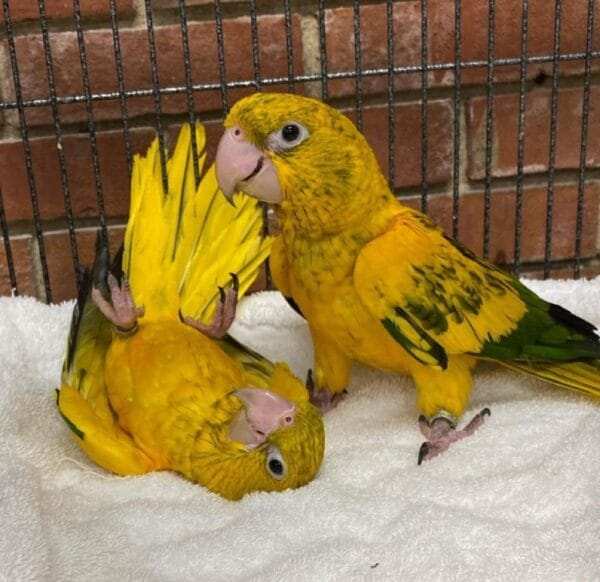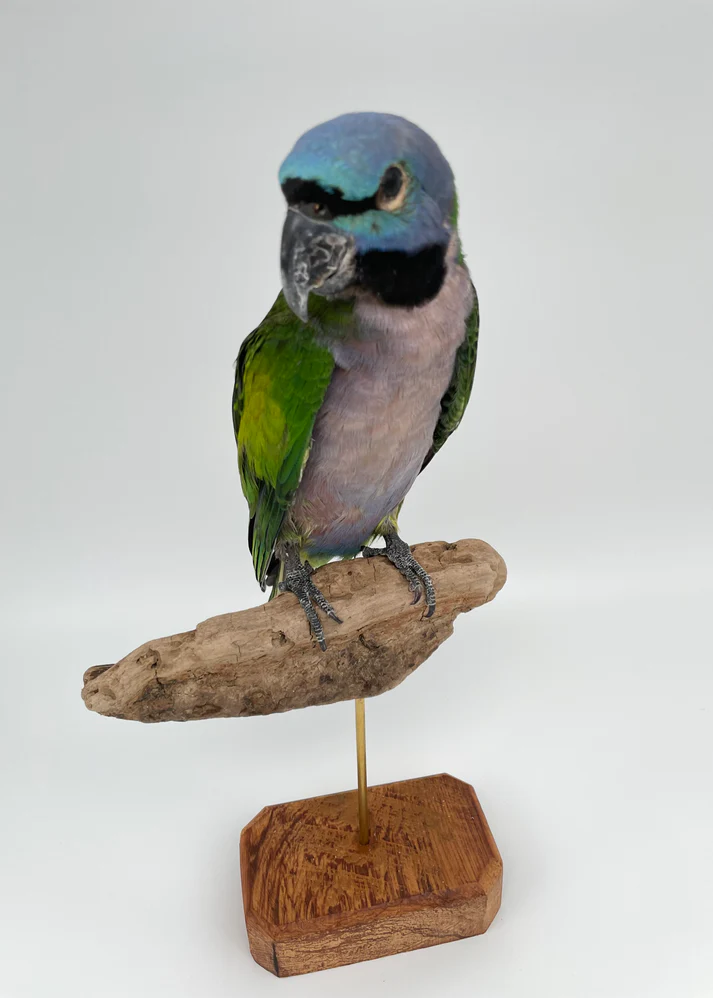What Can Parakeets Eat?
Parakeets are mainly grainvores and when living in their wild state eat seeds and grasses which account for many of them being ground feeders. Many species will forage on the forest floor or savannah and dig up various food items. They feed on seeding grasses far more than large parrots.
In the wild they also eat fruit, nectar from flowers, insects and their larvae. And like the larger parrot species, they’ll also eat tree seeds, fruits, berries, buds and bark.
Consequently, in captivity an all seed diet needs additional items to provide optimal health.
Blue-Headed Pionus
indian ringneck for sale
Tuffy – Golden Parakeet
Merlot – Moustache Parakeet
Lilly – Tui Parakeet Parrot
Urie – Indian Ring Necked Parakeet
Dusky-Headed Parakeet
Henry – Alexandrine Parakeet for Sale
Banti – Plum Headed Parakeet
What nuts, seeds and insects can parakeets eat?
Nuts are highly nutritious but must be fed sparingly.
- Acorns
- Brazil nuts
- Hazelnuts
- Horse chestnuts
- Monkey nuts – use human quality
- Peanuts – use human quality
- Pistachio
- Pumpkin seeds
- Sunflower seeds
- Walnuts
- Mealworms – live or dried
The decision as to whether pellets are better than seeds has to be an individual one. It’s also not clear-cut.
There are numerous types of pellets which vary in quality. Many parrot keepers feed a combination of the two.
Whatever the grain/pellet or seed combination that you choose – an addition of fresh vegetables, sliver of fruit and nuts must be added.
Sprouted seeds and grains, being alive, provide excellent additional nutrients that include enzymes without adding fat. Sunflower and mung are easiest if you are a beginner.
Can parakeets eat seeds and pellets suitable for other birds?
Most seeds/pellets for small birds will suit any parakeet, with the exception of lories and lorikeet mixes.
Your parakeet can eat cockatiel mix, budgie, canary and finch mixes, although the latter three are very small.
Parakeets aren’t able to handle pellets designed for large parrots such as macaws. Due to the larger size, they have trouble manipulating them in their mouth and claws.
In general you need to ensure that food items are appropriate for the size of bird. However all parrots love chewing branches of wood and eating flowers.

How many seeds or pellets should you feed a parakeet?
Amounts required for parakeets are tiny compared to larger species. Around 1/2 to 1 teaspoon for small birds, up to 1 tablespoon for larger species.
What vegetables can parakeets eat?
Parakeets can eat:
- Bok choy
- Broccoli stems and florets
- Brussel sprouts
- Butternut squash – parakeets like parrots all originating from the tropics, adore tropical fruits.
- Cabbage
- Carrots
- Celery and its leaves
- Cucumber
- Dandelion – all parts including root
- Endive
- Green lettuce
- Green peas
- Kale
- Mustard greens
- Parsley
- Peppers
- Pumpkin
- Radish
- Radishes
- Raw green beans
- Spinach
- Squashes
- Sweetcorn – a whole cob is an enrichment item
- Sweet potatoes (yams)
- Turnips
- Watercress
Vegetables need to be cut small or shredded for the smaller beaks of the parakeets.
With experience you will find out what vegetables in your home are most preferred by a particular bird.
In an aviary you need to spend a lot of time observing if you want to learn these individual preferences.
Veggies are fed raw except for yam (sweet potatoes which you might lightly cook for ease of handling and eating.)

What fruit do parakeets eat?
Parakeets can be fed the following fruit. The quantities should be tiny because of the amount of sugar.
- Apples
- Apricots – dried and soaked fruit like apricots and figs etc. use sparingly
- Banana skin
- Bananas
- Cherries
- Figs – use sparingly
- Grapefruit
- Grapes
- Kiwi
- Lemons
- Mango
- Melon – all varieties
- Nectarines
- Oranges
- Passion fruit
- Papaya
- Pear
- Persimmons
- Pineapple
- Plums
- Pomegranate seeds
- Raisins
- Raspberries
- Strawberries
- Tangerines
- Tomato – not generally liked and the leaves must be avoided
- Watermelon
In captivity parakeets are capable of eating a wide variety of fruits and vegetables. If you enjoy a certain fruit or vegetable you can always try a tiny bit with your bird.
You can also hang sprays of berries, flowers or twigs. These won’t be consumed completely and can be left out of calculating your parakeet’s complete diet.
With an adequate diet you should not need to add supplements.
What flowers do parakeets eat?
Parakeets and parrots love blossom and flowers. These flowers are safe for parakeets
They also love african violets, aster, bottlebrush, carnations, chrysanthemum, daisies, gardenias, gladiolus, hibiscus, honeysuckle, impatiens, lilac, magnolias, marigolds, nasturtium, pansies, petunias, roses, sunflowers, and violets.
Don’t use flowers from florists or commercial outlets in case they have been grown or have chemicals on them.
What do parakeets drink?
Parakeets will drink clean fresh water changed daily. Specialised teas for parrots are also becoming popular.
How to feed baby parakeets
Chick are fed by their parents . Handfeeding by humans is a tricky activity and not lightly undertaken unless you have experience or someone to guide you.
Chicks are hand-fed by syringe or a teaspoon bent at the sides to resemble a parrot’s beak. Conscientious breeders would not sell an un-weaned chick to someone without the relevant experience.
How often do parakeets eat?
You could provide two meals a day, or free feed. It’s your choice. If you have a training routine then training before a meal has a bird more eager for treats.
Clean fresh water must be always available changed once or twice a day in hot weather.
Should parakeets eat grit/gravel?
No, this is not necessary if they have foraging opportunities and branches to chew.
Why do parakeets eat their eggs?
Breeding hens need to get enough calcium in their diet provided by cuttlefish bone, calcium rich foods or possibly a supplement of liquid calcium. If a hen is lacking in calcium she may eat her own eggs.

Occasional treats for parakeets
The foods below won’t harm the bird if given in tiny amounts as an occasional treat, as a training reward or part of sharing meals together.
- Beans
- Boiled egg
- Bread
- Cake
- Chillies
- Coconut
- Meat
- Parsley
- Pasta
- Scrambled eggs
- Toast
- White rice
Birds in aviaries are unlikely to be offered much human food. However, with our pet birds we often give them some of ours. In this situation common-sense should guide you.
But much as toddlers can gorge themselves sick on junk food so can our avian toddlers eat too much of unsuitable food. A small amount of the foods (a sliver, a pinch) won’t harm a pet bird. Too much can have poor effects on liver, kidneys and other organs.
Food to avoid
You should avoid giving your parakeet coffee, caffeinated tea, alcohol, fried food, salty food, avocado, chocolate and dairy products.
Resources
Colour Mutations Some guidelines for beginners – Les Rance
Keeping Parrots Understanding their care and breeding – Alan K Jones
If you want to cook for pet or aviary parakeets this book is invaluable:
A Parrot’s Fine Cuisine Cookbook Nutritional Guide – Karmen Buchai and Shean Pao










